Content
-
1 Air purification in the kitchen
- 1.1 Supply and exhaust balance
- 1.2 Types of ventilation devices
-
2 Fan selection and installation
- 2.1 Model selection by parameters
- 2.2 Determination of fan performance
- 2.3 Mounting the device
Kitchen exhaust fans are widely used today to provide an optimal balance between air supply and exhaust. This is primarily due to the fact that the technical characteristics of obsolete ventilation ducts in buildings of the old the buildings do not correspond to the increasing load - which means that the air from the kitchen must be removed forced.
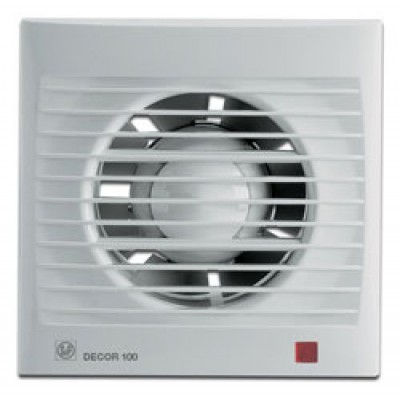
Kitchen fan for air extraction
Air purification in the kitchen
Supply and exhaust balance
One of the most important indicators that determines how comfortable you will be in a room is air quality. And if for other rooms of your house this indicator just needs to be taken into account, then for the kitchen its importance is paramount.
This is due, of course, to the cooking processes, during which:
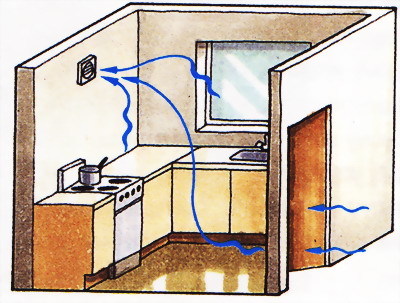
Air flow pattern
- Oxygen is actively burned;
- Carbon monoxide and carbon dioxide are formed;
- Due to the evaporation of the liquid, humidity increases;
- Unpleasant odors appear.
All this has an extremely negative effect on the level of comfort, and therefore the kitchen is exactly the room in which it is imperative to maintain an optimal balance between air supply and exhaust (find out also about the most successful kitchen layout options with a ventilation box in the corner).
What is this balance?
- As a rule, kitchens are equipped with hoods located above the stove. The main task of the hood is to actively remove polluted air into the ventilation ducts of the building or into the external environment during the cooking process.
- Together with the hood, experts often recommend the use of kitchen exhaust fans. Such a device can be both an alternative to an exhaust hood, and an addition to it: by and large, an exhaust kitchen fan performs the same tasks.
Note! Simultaneous operation of the hood and fan installed in the same ventilation duct can lead to a complete blockage of the air outlet for all neighbors located above. Consider this when planning the placement of appliances in the kitchen.
- In order for the outlet devices to work efficiently (i.e., to realize their full design capacity), it is also necessary to take care of the fresh air flow. There are several ways to ensure optimal air flow, and the simplest one is regular ventilation.
- Also, in order to optimize the flow, experts recommend leaving a gap between the floor and the bottom of the kitchen door.
- And yet the best way to solve this problem is to install an automatic supply valve in a wall or window. This device will ensure the flow of air into the room, depending on the activity of the fan, and at the same time will save the kitchen from hypothermia.
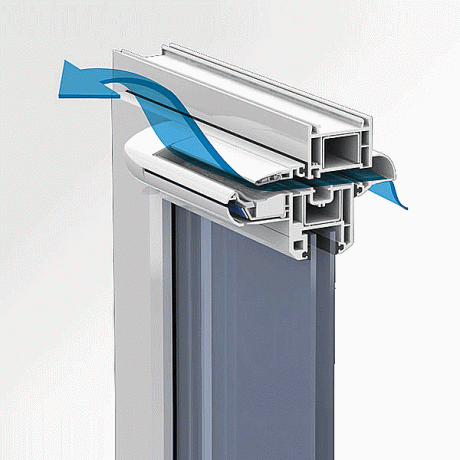
The principle of operation of the supply valve
As you can see, the solution to the issue of optimal air exchange in the kitchen is possible only with an integrated approach. It will not be possible to make the fan work efficiently without providing the necessary inflow. Well, if everything is in order with the inflow, then you can proceed to the choice of an output device (also find out all the nuances of a difficult process - how to choose a hood for the kitchen).
Types of ventilation devices
Domestic kitchen fans on the market most often have a similar design. The basis of the device is a rotor on which blades of a special shape are fixed. When the rotor rotates, the blades create a directional flow that promotes the movement of air in a given direction.
By the type of rotor and the design of the blades, all devices are divided into the following categories:
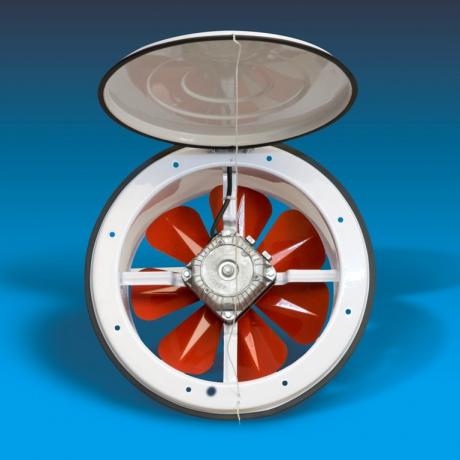
The axial model is the most common
- Axial (axial) Is the most common variety. In such designs, the blades move air along the axis on which they are attached. It is axial fans that are most often used in kitchens in apartments and private houses. Also, axial models are used in other rooms - baths, bathrooms, workshops, etc.
- Radial (centrifugal) - equipped with a rotor with spiral blades. The principle of operation is clearly shown in the photo in this article. Centrifugal models are used in industry and in kitchens of public catering establishments, and in private houses and apartments, radial-type devices are used extremely rarely.

The principle of operation of radial devices
- Diametric - have a cylindrical rotor, the walls of which are represented by blades curved inward (this type of rotor is called "Squirrel cage"). When the rotor rotates, air is captured by vane blades and a uniform ceiling is removed into the ventilation duct.
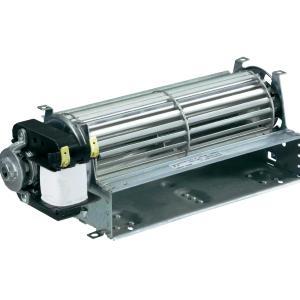
Diametrical model for professional kitchens
In addition to the types mentioned, duct devices are also used to ensure effective air removal. They are vane-type fans, which are not installed indoors, but directly in the ventilation ducts. The advantage of these models is that when they are installed, the appearance of the room does not suffer, since only the decorative grill remains in the kitchen itself.
Note! Experts recommend using duct-type structures only if the condition of the building's ventilation ducts allows it.
There is also a classification according to the place of installation of the structure:
- Window - are mounted in a window in the kitchen, while removing air to the outside.
- Wall - can be installed both on internal and external walls. In the first case, air is removed by means of ventilation ducts, and in the second case, the wall model works similarly to the window model.
Fan selection and installation
Model selection by parameters
When choosing a fan for the kitchen, you should focus on the following parameters:
- Power - the volume of air that the fan removes from the room per unit of time, operating in normal mode. As a rule, this parameter is measured in cubic meters per hour.
- Loudness of work. As a rule, powerful models are quite noisy, and this, in turn, reduces the level of comfort in the room. It is for this reason that you need to be very careful about the selection of a device for this parameter.
- The optimal indicator will be from 30 to 70 decibels. In most cases, to ensure a comfortable noise level, the device body is equipped with special soundproofing pads.
- Operational safety. It is important that the design features allow the device to be used in a room with high humidity and high air temperatures. For kitchens, hoods with built-in thermal protection are suitable. These include, for example, the Systemair KBT kitchen fan, designed for temperatures up to 1200FROM.
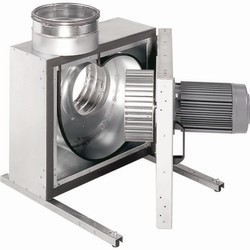
Systemair KBT model
- In addition to these parameters, of which, by and large, the model price, there are also additional functions. These include grease filters, timers, presence detectors, etc. They do not directly affect the operation of the fan, but they make it more comfortable (also find out all the points of the complex process - how to calculate the power of the hood for the kitchen).
Determination of fan performance
Yet the most important parameter is power. Kitchen models in most cases have significantly higher performance than models for bathrooms and toilets.
You can determine the minimum required power of the device using the formula:
W = S * h * 10where:
- W - required capacity, m3/ч.
- S - kitchen area, m2.
- H - height from floor to ceiling, m.
- 10 - the frequency of air exchange (i.e., within an hour, all the air in the kitchen must be changed at least 10 times).
Note! When calculating the power of an exhaust kitchen fan, many experts recommend subtracting the volume occupied by kitchen furniture or household appliances from the volume of the room. In most apartment buildings, this should not be desired, since the emergency state of the ventilation ducts will inevitably "eat" part of the device's power.
When the model is selected, it remains to figure out how to connect a fan in the kitchen.
Mounting the device
Depending on the place of installation, the exhaust device is mounted using different technologies. Below are instructions for installing window and wall models.
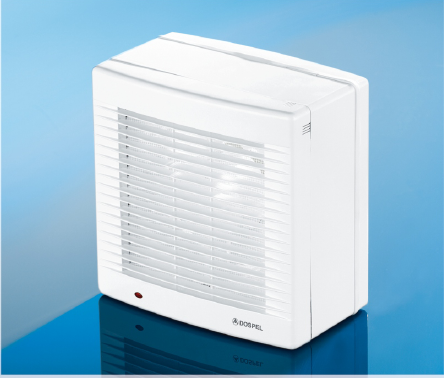
Window fan
We install the window fan with our own hands as follows:
- First, choose a place to install. It is best to mount the device at the maximum height, but not less than 20 cm from the edge of the window pane.
- Having applied the markings to the glass, use a glass cutter to make a hole. The diameter of the hole must be equal to the diameter of the fan cover
- We put on rubber protectors on the casing, after which we install the structure into the hole in the window glass.
- We attach pressure tapes to the outer flange. Tightening the fastening screws, we finally fix the product on the window. After fixing, cut off excess tapes.
- We install the working unit in the casing, leveling it so that the blades do not touch the walls during rotation.
- We connect the power supply and carry out a test run. If everything is in order, install an internal protective grill.
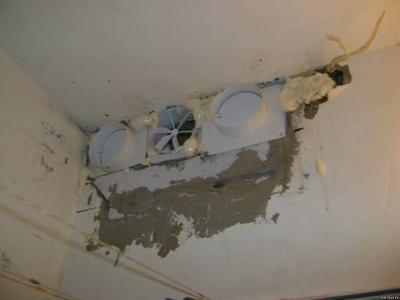
Housings installed in the ventilation duct
With wall models, it will be somewhat more complicated:
- Determine where the ventilation duct runs in the wall.
- Using a perforator with a drill on concrete, we make several holes, which we then connect by making one large socket for installing the branch pipe. How to make such holes is clearly shown in the video instructions posted on the site.
- We insert the branch pipe into the wall, after which we mount the fan itself, securing it with anchors.
- If the hole does not go out into the ventilation duct, but outward, we put on an external protective grill.

Securing the wall part
As in the first case, we do a test run, and if there are no problems with the device, we put on an internal decorative overlay.
A household fan for the kitchen is not that irreplaceable, but very useful. At the same time, its compact size and high performance make the device a very effective assistant in the kitchen - after all, working in the fresh air is much more pleasant!

